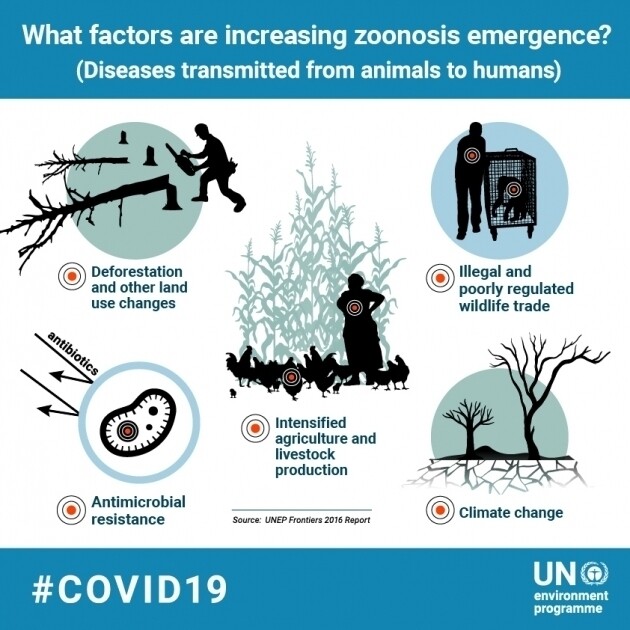
Protecting old growth forests are among the most strategic responses to guard against future infectious disease outbreaks. Infographic by UNEP
Did you know that around 60 per cent of all infectious diseases, and 75 per cent of all emerging infectious diseases, in humans are zoonotic – in other words they come to us via animals?
Zoonotic diseases that emerged or re-emerged recently are Ebola, bird flu, Middle East respiratory syndrome (MERS), the Nipah virus, Rift Valley fever, sudden acute respiratory syndrome (SARS), West Nile virus, Zika virus disease, and now coronavirus. They are all linked to human activity. The Ebola outbreak in West Africa was the result of forest losses leading to closer contacts between wildlife and human settlements; the emergence of avian influenza was linked to intensive poultry farming; and the Nipah virus was linked to the intensification of pig farming and fruit production in Malaysia.
Scientists and specialists working at the United Nations Environment Programme (UNEP) have been pulling together the latest scientific facts about the coronavirus—what we know about the virus and what we don’t know. While the origin of the outbreak and its transmission pathway are yet to be discovered, here are six important points worth knowing:
- The interaction of humans or livestock with wildlife exposes them to the risk of spillover of potential pathogens. For many zoonotic diseases, livestock serve as an epidemiological bridge between wildlife and human infections.
- The drivers of zoonotic disease emergence are changes in the environment—usually the result of human activities,
- ranging from land use change to changing climate; changes in animals or human hosts; and changes in pathogens, which always evolve to exploit new hosts.
- For example, bat-associated viruses emerged due to the loss of bat habitat from deforestation and agricultural expansion. Bats play important roles in ecosystems by being night pollinators and eating insects.
- Ecosystem integrity underlines human health and development. Human-induced environmental changes modify wildlife population structure and reduce biodiversity, resulting in new environmental conditions that favour particular hosts, vectors, and/or pathogens.
- Ecosystem integrity can help regulate diseases by supporting a diversity of species so that it is more difficult for one pathogen to spill over, amplify or dominate.
- It is impossible to predict where the next outbreak will come from or when it will be. Growing evidence suggests that outbreaks or epidemic diseases may become more frequent as climate continues to change.
We are intimately interconnected with nature, whether we like it or not. If we don’t take care of nature, we can’t take care of ourselves. And as we hurtle towards a population of 10 billion people on this planet, we need to go into this future armed with nature as our strongest ally.
Never before have so many opportunities existed for pathogens to pass from wild and domestic animals to people. Our continued erosion of wild spaces has brought us uncomfortably close to animals and plants that harbour diseases that can jump to humans. Our long-term response must tackle habitat and biodiversity loss.
– United Nations Environment Programme Executive Director Inger Andersen.
